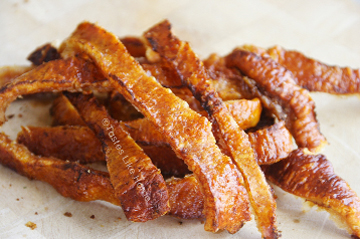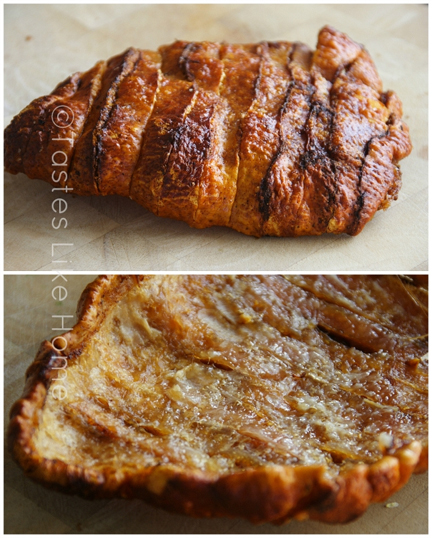Hi Everyone, One of the main reasons I like to cook roast pork is just so that I can make and eat the cracklings. Done right, there will be a fight for every piece.
Crackling is the rind or skin that sits above a layer of fat and meat of roasting pork. There are various names and methods associated with cracklings – from Europe to Asia to Latin America. Some of you may be more familiar with Mexican or Puerto Rican chicharrón –fried pork fat with skin found just above the meat. This is also known as crackling. However, the crackling that is the subject of this column, refers to the skin on top of the fat and meat that once roasted, becomes crisp and hard to the touch but crunchy to the bite. You know the crackling is done perfectly right when you can easily lift the crackling away from the meat and the fat has melted.
 Just like a roast chicken, there are numerous recipes, suggestions and ways to roast pork so that the skin is cooked in such a manner that it becomes crackling, while at the same time, the meat becomes fork tender with succulent morsels. A lot of recipes and suggestions involve more than one method of cooking. Some require the meat to be boiled or blanched first then roasted. Others suggest starting the cooking on the stovetop and then finishing it in the oven.
Just like a roast chicken, there are numerous recipes, suggestions and ways to roast pork so that the skin is cooked in such a manner that it becomes crackling, while at the same time, the meat becomes fork tender with succulent morsels. A lot of recipes and suggestions involve more than one method of cooking. Some require the meat to be boiled or blanched first then roasted. Others suggest starting the cooking on the stovetop and then finishing it in the oven.
My craving for homemade crackling got started when I wanted to make the elusive Siew Yuk (Chinese crispy roast pork), which I did, back in 2009. It required that the meat be cooked at high heat and to be brushed with vinegar a couple of times during the cooking process, to aid in the blistering, puffing and ultimate crispness of the crackling. While my first attempt at making Siew Yuk was successful, I wanted to find a way to have my pork roasts yield crackling without too much fussing. A year later, in 2010, through a couple of friends online, I found a way that gives me perfect crackling, every time, without fuss. The key is to slow roast the pork on low heat and then in the last half hour crank up the heat and turn the skin into crackling that you can rap, snap and pop right into your mouth.
The meat

First, you want to start with a cut of meat that facilitates long cooking and results in moist, tender meat. A piece of meat that stands up to long slow cooking. Pork shoulder, pork belly (pork flap) or untrimmed pork ribs (skin and fat on) would be perfect for slow roasting and yielding crackling. With the other cuts, which are usually more expensive – the legs and loin, the meat can dry out given the lack of fat or bone and more importantly the time needed for the skin to be transformed into crackling.
Scoring & salting
For great crackling, you want to score the skin and the fat. The cut is made deep enough to separate the skin, and reveal the fat but not so deep that you cut into the meat. The point in scoring the skin and fat is so that the seasoning (mostly salt) can be applied easily and thoroughly.
Now to score the skin/fat, you need to work with a very sharp cutting tool. A super sharp paring knife would do but barring that, use a Stanley knife, a new razor blade or an X-Acto knife. I actually bought an X-Acto knife with a set of blades to use for scoring meat and other things for cooking. Pick up a set if you can, if not, a new razor blade would do.
Pat the meat the dry. You want the skin to be really dry. If the skin is not dry then you won’t get great crackling. Generously season the meat all over. I tend to use an all-purpose dry seasoning along with salt. Or sometimes I use Chinese five-spice powder with salt. You can play around with the flavours. Be sure to get the salt and seasoning into the crevices between the slits you created. Stephen Seckold, head chef at Sydney’s Flying Fish says, “The fat under the skin reacts with the salt – that is what makes the skin puff up and crisp up.”

In terms of marinating, you can do this about 15 minutes before you put the meat into the oven or overnight. You will notice that once the salt is added, the skin will start to get wet, that’s because the salt is melting. Don’t fuss, just take paper towels and keep blotting (not rubbing!) until you are ready to put the meat into the oven. Roast pork for me is usually something that I plan ahead and mostly only make on the weekends, so what I do is season the meat on the Saturday night and refrigerate it. In the morning, I remove it from the refrigerator to come up to room temperature and blot away the moisture from the skin and leave the meat to air dry until I am ready to put it into the oven. As it comes up to room temperature, it will keep getting bits of moisture on the skin, just simply blot.
Cooking
This is not a quick-cook dish, so plan ahead, as it takes a few hours for the meat to cook. What I would do is get up early on the morning (around 7 or 8) to bring the meat up to room temperature (takes about 1 hour) and then put it into the oven. It is ready to serve at 12 noon or 1 pm. The timing will always be dependent on the weight of the meat.
Cooking it on low heat ensures that the meat is cooked all the way through, the fat melted and the skin is fully cooked and ready to be crisped. With the meat cooked, fat melted and skin ready, turn up the heat to high so that the skin can become really crisp, blistered and crunchy.
When the roast is removed from the oven, let it cool uncovered. The meat and its juices settle and the skin becomes easy to remove. I mean you won’t even have to use a knife. You can pry the cracking from the meat with your bare hands. Rap it with your knuckles; you’ll hear how hollow it sounds. The fat is gone. Lift the crackling off of the meat; snap it into the precut pieces or even smaller pieces. Go ahead, you have to taste it so pop a piece, or two, or three into your mouth. Now debate how to fairly divide the crackling to those waiting to eat. Of course you don’t count what you have already eaten; that’s the cook’s share.
Cynthia








